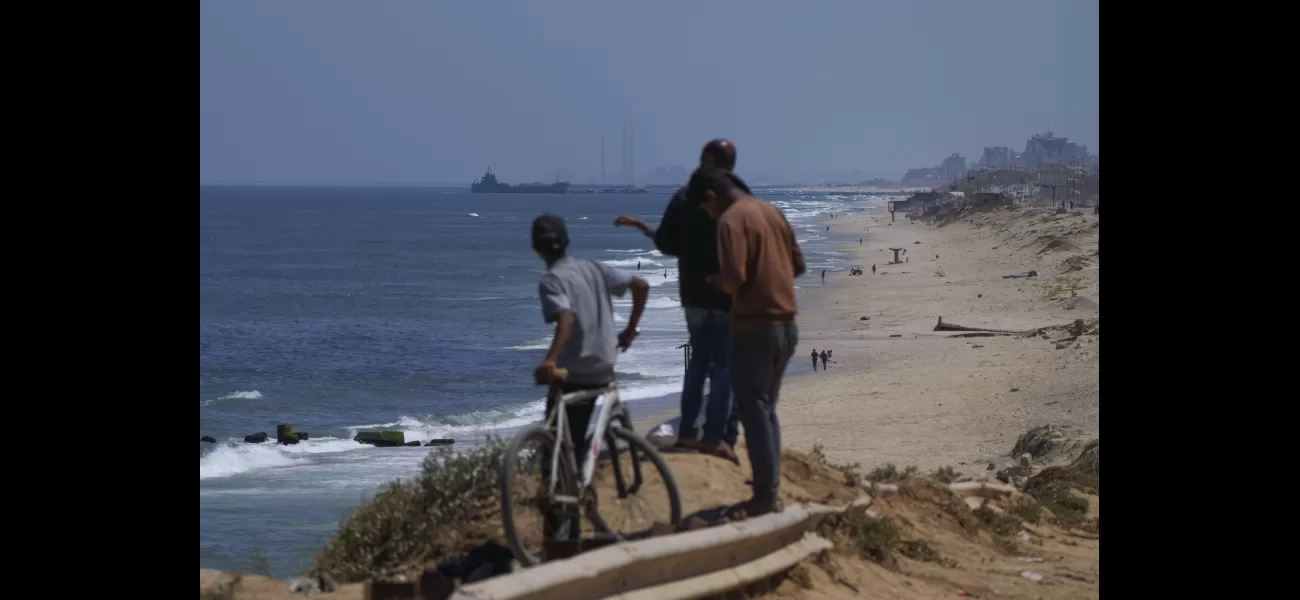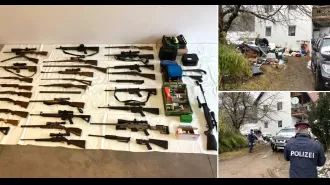US confirms Gaza pier work done, aid coming soon.
US military installs floating pier near Gaza Strip to transport aid to war-torn enclave after 7 months of intense conflict between Israel and Hamas.
May 16th 2024.

The United States military has recently completed the construction of a floating pier off the coast of the Gaza Strip. This pier will serve as a key point for delivering much-needed humanitarian aid to the besieged enclave, which has been ravaged by intense fighting between Israel and Hamas for over seven months now.
This endeavor was initiated by US President Joe Biden, who recognized the dire situation of the Palestinians in Gaza. With Israeli restrictions on border crossings and ongoing conflict preventing the delivery of essential supplies, the US government stepped in to provide assistance.
The construction of the pier was a complex and challenging process, involving logistical, weather, and security concerns. The project, which cost $320 million, is expected to increase the amount of aid reaching Gaza. However, it is not meant to replace the more sustainable land deliveries that aid agencies have been advocating for.
The aid will be transported to a port facility built by the Israelis, located just southwest of Gaza City. From there, it will be distributed by various aid groups. According to US officials, around 500 tons of food will soon be arriving on the shores of Gaza. Close coordination with Israel has been essential to ensure the safety and security of the ships and personnel involved in this operation.
However, there are still challenges to be overcome. Sonali Korde, assistant to the administrator of the US Agency for International Development, has expressed concerns about the volatile operating environment in Gaza. Aid groups are facing difficulties in obtaining clearance for their movements, and there is a need for a secure and stable environment for them to operate in.
The ongoing conflict between Israeli troops and Palestinian militants near the southern city of Rafah, as well as Israel's recent takeover of the key Rafah border crossing, have resulted in the displacement of over 700,000 people. The situation in Gaza is dire, and the United Nations has termed it a "new and horrific stage" of the war.
The safety of US forces involved in this aid delivery mission is a top priority for the Pentagon. As a result, a comprehensive security plan has been developed in collaboration with Israel to protect all personnel. Navy Vice Adm. Brad Cooper, deputy commander at the US military's Central Command, has expressed confidence in the effectiveness of this plan.
On Thursday morning, US troops successfully anchored the pier, with no need for them to enter the Gaza Strip. Trucks carrying aid will be arriving in the coming days, and the United Nations will be responsible for its distribution. The UK's RFA Cardigan Bay will also be providing support, along with two US Navy destroyers equipped with advanced weapons and capabilities to protect American troops and allies on the beach.
Israeli military spokesman Lt. Col. Nadav Shoshani has confirmed that the pier has been attached, and Israeli engineering units have prepared the surrounding area for the safe arrival of the aid. Israel has been working closely with the US on this project and considers it a top priority in their operation.
The UN, US, and international aid groups have accused Israel of restricting the entry of humanitarian aid into Gaza, leading to a dire shortage of food and fuel. However, Israel maintains that it places no limits on aid and blames the UN for delays in distribution. The chaotic security conditions and ongoing fighting have also hindered the delivery of aid.
The first shipment of food from Cyprus has reached a US military ship off the coast of Gaza. The construction of the floating pier and causeway was delayed due to bad weather, but deliveries will now begin slowly to ensure the system functions smoothly. It is estimated that around 90 truckloads of aid will be transported each day through this sea route, increasing to 150 trucks a day in the near future.
However, aid agencies stress that this is not enough to avert famine in Gaza. They argue that Israel should open land corridors to allow for the delivery of all necessary aid. According to Scott Paul, an associate director of the Oxfam humanitarian organization, the US-built pier-and-sea route is not a solution to the problem at hand.
Under this new sea route, aid will be transported to Cyprus for inspection and security checks before being loaded onto ships and taken to the floating pier off the coast of Gaza. From there, trucks will transport the aid to the causeway, where it will be shuttled to a secure area on land. Aid groups will then collect and distribute the supplies to those in need.
This endeavor was initiated by US President Joe Biden, who recognized the dire situation of the Palestinians in Gaza. With Israeli restrictions on border crossings and ongoing conflict preventing the delivery of essential supplies, the US government stepped in to provide assistance.
The construction of the pier was a complex and challenging process, involving logistical, weather, and security concerns. The project, which cost $320 million, is expected to increase the amount of aid reaching Gaza. However, it is not meant to replace the more sustainable land deliveries that aid agencies have been advocating for.
The aid will be transported to a port facility built by the Israelis, located just southwest of Gaza City. From there, it will be distributed by various aid groups. According to US officials, around 500 tons of food will soon be arriving on the shores of Gaza. Close coordination with Israel has been essential to ensure the safety and security of the ships and personnel involved in this operation.
However, there are still challenges to be overcome. Sonali Korde, assistant to the administrator of the US Agency for International Development, has expressed concerns about the volatile operating environment in Gaza. Aid groups are facing difficulties in obtaining clearance for their movements, and there is a need for a secure and stable environment for them to operate in.
The ongoing conflict between Israeli troops and Palestinian militants near the southern city of Rafah, as well as Israel's recent takeover of the key Rafah border crossing, have resulted in the displacement of over 700,000 people. The situation in Gaza is dire, and the United Nations has termed it a "new and horrific stage" of the war.
The safety of US forces involved in this aid delivery mission is a top priority for the Pentagon. As a result, a comprehensive security plan has been developed in collaboration with Israel to protect all personnel. Navy Vice Adm. Brad Cooper, deputy commander at the US military's Central Command, has expressed confidence in the effectiveness of this plan.
On Thursday morning, US troops successfully anchored the pier, with no need for them to enter the Gaza Strip. Trucks carrying aid will be arriving in the coming days, and the United Nations will be responsible for its distribution. The UK's RFA Cardigan Bay will also be providing support, along with two US Navy destroyers equipped with advanced weapons and capabilities to protect American troops and allies on the beach.
Israeli military spokesman Lt. Col. Nadav Shoshani has confirmed that the pier has been attached, and Israeli engineering units have prepared the surrounding area for the safe arrival of the aid. Israel has been working closely with the US on this project and considers it a top priority in their operation.
The UN, US, and international aid groups have accused Israel of restricting the entry of humanitarian aid into Gaza, leading to a dire shortage of food and fuel. However, Israel maintains that it places no limits on aid and blames the UN for delays in distribution. The chaotic security conditions and ongoing fighting have also hindered the delivery of aid.
The first shipment of food from Cyprus has reached a US military ship off the coast of Gaza. The construction of the floating pier and causeway was delayed due to bad weather, but deliveries will now begin slowly to ensure the system functions smoothly. It is estimated that around 90 truckloads of aid will be transported each day through this sea route, increasing to 150 trucks a day in the near future.
However, aid agencies stress that this is not enough to avert famine in Gaza. They argue that Israel should open land corridors to allow for the delivery of all necessary aid. According to Scott Paul, an associate director of the Oxfam humanitarian organization, the US-built pier-and-sea route is not a solution to the problem at hand.
Under this new sea route, aid will be transported to Cyprus for inspection and security checks before being loaded onto ships and taken to the floating pier off the coast of Gaza. From there, trucks will transport the aid to the causeway, where it will be shuttled to a secure area on land. Aid groups will then collect and distribute the supplies to those in need.
[This article has been trending online recently and has been generated with AI. Your feed is customized.]
[Generative AI is experimental.]
0
0
Submit Comment





